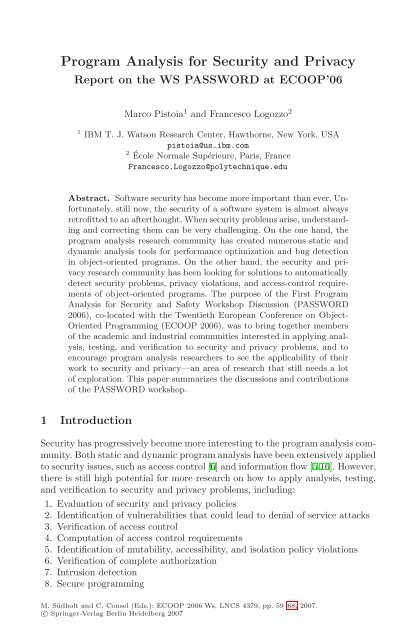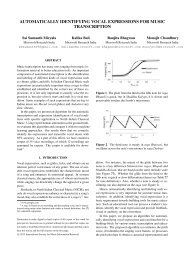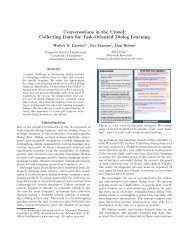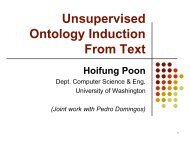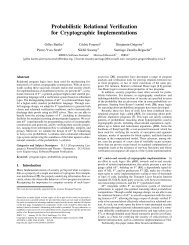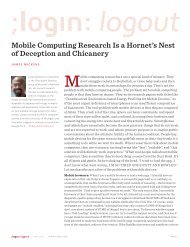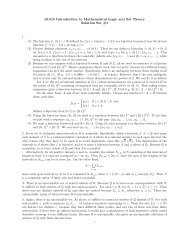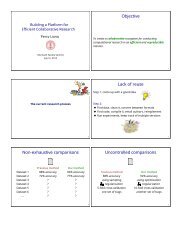PDF file - Microsoft Research
PDF file - Microsoft Research
PDF file - Microsoft Research
You also want an ePaper? Increase the reach of your titles
YUMPU automatically turns print PDFs into web optimized ePapers that Google loves.
Program Analysis for Security and Privacy<br />
Report on the WS PASSWORD at ECOOP’06<br />
Marco Pistoia 1 and Francesco Logozzo 2<br />
1 IBM T. J. Watson <strong>Research</strong> Center, Hawthorne, New York, USA<br />
pistoia@us.ibm.com<br />
2 École Normale Supérieure, Paris, France<br />
Francesco.Logozzo@polytechnique.edu<br />
Abstract. Software security has become more important than ever. Unfortunately,<br />
still now, the security of a software system is almost always<br />
retrofitted to an afterthought. When security problems arise, understanding<br />
and correcting them can be very challenging. On the one hand, the<br />
program analysis research community has created numerous static and<br />
dynamic analysis tools for performance optimization and bug detection<br />
in object-oriented programs. On the other hand, the security and privacy<br />
research community has been looking for solutions to automatically<br />
detect security problems, privacy violations, and access-control requirements<br />
of object-oriented programs. The purpose of the First Program<br />
Analysis for Security and Safety Workshop Discussion (PASSWORD<br />
2006), co-located with the Twentieth European Conference on Object-<br />
Oriented Programming (ECOOP 2006), was to bring together members<br />
of the academic and industrial communities interested in applying analysis,<br />
testing, and verification to security and privacy problems, and to<br />
encourage program analysis researchers to see the applicability of their<br />
work to security and privacy—an area of research that still needs a lot<br />
of exploration. This paper summarizes the discussions and contributions<br />
of the PASSWORD workshop.<br />
1 Introduction<br />
Security has progressively become more interesting to the program analysis community.<br />
Both static and dynamic program analysis have been extensively applied<br />
to security issues, such as access control [6] and information flow [5,16]. However,<br />
there is still high potential for more research on how to apply analysis, testing,<br />
and verification to security and privacy problems, including:<br />
1. Evaluation of security and privacy policies<br />
2. Identification of vulnerabilities that could lead to denial of service attacks<br />
3. Verification of access control<br />
4. Computation of access control requirements<br />
5. Identification of mutability, accessibility, and isolation policy violations<br />
6. Verification of complete authorization<br />
7. Intrusion detection<br />
8. Secure programming<br />
M. Südholt and C. Consel (Eds.): ECOOP 2006 Ws,<br />
LNCS 4379, pp. 59–68, 2007.<br />
c○ Springer-Verlag Berlin Heidelberg 2007
60 M. Pistoia and F. Logozzo<br />
This paper summarizes the contributions of the First Program Analysis for Security<br />
and Safety Workshop Discussion (PASSWORD 2006), co-located with<br />
the Twentieth European Conference on Object-Oriented Programming (ECOOP<br />
2006), which was held in Nantes, France in July 2006.<br />
2 Objective and Call for Papers<br />
With the advent of the Internet, software security has become more important<br />
than ever. Unfortunately, still now, the security of a software system is almost<br />
always an afterthought. When security problems arise, understanding and correcting<br />
them can be very challenging. On the one hand, the program analysis<br />
research community has created numerous static and dynamic analysis tools for<br />
performance optimization and bug detection in object-oriented programs. On<br />
the other hand, the security and privacy research community has been looking<br />
for solutions to automatically detect security problems, privacy violations, and<br />
access-control requirements of object-oriented programs. The purpose of PASS-<br />
WORD 2006 was to bring together members of both these communities and to<br />
encourage program analysis researchers to see the applicability of their work to<br />
security and privacy—an area of research that still needs exploration.<br />
Two types of papers were welcomed at PASSWORD 2006: technical papers,<br />
which present mature technical and research material, and position, exploratory,<br />
or preliminary-work papers, which may describe work in progress or new research<br />
ideas.<br />
Topics of interest for PASSWORD included, but were not limited to:<br />
– Analysis of cryptographic systems and implementations<br />
– Analysis of network and security protocols<br />
– Automatic detection of attacks against networks and machines<br />
– Automated tools for source- and compiled-code analysis<br />
– Authentication and authorization of users, systems, and applications<br />
– Bug finding<br />
– Detection of mutability, accessibility, and isolation policy violations<br />
– Identification of denial-of-service attacks<br />
– Input validation<br />
– Intrusion and anomaly detection<br />
– Language-based security<br />
– Operating system security<br />
– Privacy analysis<br />
– Security in heterogeneous and large-scale environments<br />
– Security in the presence of agents and mobile code<br />
– Security policy analysis<br />
– Static analysis for program verification<br />
– Static analysis techniques for soundness, precision, and scalability
Program Analysis for Security and Privacy 61<br />
3 Program Organization and Participants<br />
3.1 Organizers<br />
PASSWORD 2006 was organized by Marco Pistoia and Francesco Logozzo.<br />
– Marco Pistoia, Ph. D. is a <strong>Research</strong> Staff Member in the Programming<br />
Languages and Software Engineering Department at the IBM T. J. Watson<br />
<strong>Research</strong> Center in Hawthorne, New York, USA. He has written ten books,<br />
<strong>file</strong>d thirteen patents, and published numerous papers and journal articles<br />
on all areas of Java and program analysis for security. Most recently, he has<br />
published his Ph.D. thesis, and has been the lead author of the books Enterprise<br />
Java Security, published by Addison-Wesley in 2004 (and now available<br />
in Chinese), and Java 2 Network Security, published by Prentice Hall PTR<br />
in 1999. He has published and presented at several conferences worldwide<br />
and has been invited to give lectures and teach at several universities and<br />
research centers. He received his Ph. D. in Mathematics from Polytechnic<br />
University, Brooklyn, New York in May 2005 with a thesis entitled A Unified<br />
Mathematical Model for Stack- and Role-Based Authorization Systems, and<br />
his Master of Science and Bachelor of Science degrees in Mathematics summa<br />
cum laude from the University of Rome, Italy in 1995, with a research thesis<br />
entitled Theory of Reductive Algebraic Groups and Their Representations.<br />
– Francesco Logozzo, Ph. D. is a Postdoctoral <strong>Research</strong>er at the École<br />
Normale Supérieure, Paris, France. He graduated from École Polytechnique,<br />
Paris, France in June 2004 with a thesis entitled Modular Static Analysis<br />
of Object-oriented Languages. His Ph. D. advisor was Dr. Radhia Cousot.<br />
He was a former student of the Scuola Normale Superiore of Pisa, Italy. He<br />
is the author of more than ten papers on static analysis of object-oriented<br />
languages. He co-chaired the First Workshop on Abstract Intepretation of<br />
Object-Oriented Languages (AIOOL 2005) and the Seventh Workshop of<br />
Formal Techniques for Java-like Programs (FTfJP 2005).<br />
3.2 Program Committee Members<br />
The committee members were program analysis and security experts from<br />
academia and industry:<br />
– Sabrina De Capitani Di Vimercati, University of Milan, Milan, Italy<br />
– Stephen J. Fink, IBM T. J. Watson <strong>Research</strong> Center, Hawthorne, New<br />
York, USA<br />
–RobertJ.Flynn, Polytechnic University, Brooklyn, New York, USA<br />
– Charles Hymans, European Aeronautic Defence and Space Company, Paris,<br />
France<br />
– Trent Jaeger, Pennsylvania State University, University Park, Pennsylvania,<br />
USA<br />
– Francesco Logozzo, École Normale Supérieure, Paris, France<br />
–NasirMemon, Polytechnic University, Brooklyn, New York, USA
62 M. Pistoia and F. Logozzo<br />
– Greg Morrisett, Harvard University, Cambridge, Massachusetts, USA<br />
–David A. Naumann, Stevens Institute of Technology, Hoboken, New<br />
Jersey, USA<br />
–MarcoPistoia, IBM T. J. Watson <strong>Research</strong> Center, Hawthorne, New York,<br />
USA<br />
–JanVitek, Purdue University, West Lafayette, Indiana, USA<br />
–EranYahav, IBM T. J. Watson <strong>Research</strong> Center, Hawthorne, New York,<br />
USA<br />
–SteveZdancewic, University of Pennsylvania, Philadelphia, Pennsylvania,<br />
USA<br />
– Xiaolan Zhang, IBM T. J. Watson <strong>Research</strong> Center, Hawthorne, New York,<br />
USA<br />
– Roberto Zunino, University of Pisa, Pisa, Italy<br />
3.3 Participants<br />
Participation to the PASSWORD 2006 workshop was allowed also through remote<br />
connection for people unable to attend in person. The list of participants<br />
included:<br />
– Paolina Centonze, IBM T. J. Watson <strong>Research</strong> Center, Hawthorne, New<br />
York, USA<br />
– Tzi-cker Chiueh, Computer Science Department, Stony Brook University,<br />
Stony Brook, New York, USA<br />
– Holger Grandy, University of Augsburg, Augsburg, Germany<br />
– Francesco Logozzo, École Normale Supérieure, Paris, France<br />
–YiLu, School of Computer Science and Engineering, The University of New<br />
South Wales, Sydney, Australia<br />
– Eric Madelaine, INRIA, Centre Sophia Antipolis, Sophia Antipolis, France<br />
–MichaelMcIntosh, IBM T. J. Watson <strong>Research</strong> Center, Hawthorne, New<br />
York, USA<br />
– Nicholas Nguyen, Department of Informatics, University of Sussex,<br />
Brighton, UK<br />
–MarcoPistoia, IBM T. J. Watson <strong>Research</strong> Center, Hawthorne, New York,<br />
USA<br />
–JanVitek, Purdue University, West Lafayette, Indiana, USA<br />
– Jian Yin, IBM T. J. Watson <strong>Research</strong> Center, Hawthorne, New York, USA<br />
– Xiaolan Zhang, IBM T. J. Watson <strong>Research</strong> Center, Hawthorne, New York,<br />
USA<br />
4 Summary of Contributions<br />
An important area of application for program analysis is intrusion detection.<br />
Host-based intrusion detection systems attempt to identify attacks by discovering<br />
program behaviors that deviate from expected patterns. While the idea<br />
of performing behavior validation on-the-fly and terminating errant tasks as
Program Analysis for Security and Privacy 63<br />
soon as a violation is detected is appealing, this presents numerous practical<br />
and theoretical challenges. Vitek [20] focuses on automated intrusion detection<br />
techniques—techniques that do not require human intervention. Of particular interest<br />
are techniques that rely on, or leverage, programming language semantics<br />
to find novel ways of detecting attacks [3]. Vitek reviews the main attack models,<br />
describes the state of the art in host-based intrusion detection techniques, and<br />
concludes with a list of challenges for the research community.<br />
Another interesting area of research is program analysis applied to access<br />
control and information flow. Pistoia [13] presents a static analysis framework<br />
for statically representing the execution of software programs and the flow of<br />
security information in those programs. The results of the analysis can be used<br />
to automatically identify security properties of software and evaluate security<br />
policies. The analysis can be applied to define or evaluate security policies in<br />
both Stack-Based Access Control (SBAC) systems [6], such as Java, Standard<br />
Edition (SE) [18] and .NET Common Language Runtime (CLR) [2], and Role-<br />
Based Access Control (RBAC) systems [14], such as Java, Enterprise Edition<br />
(EE) [17] and CLR. In an SBAC system, when access to a security-sensitive resource<br />
is attempted, all the callers on the current stack of execution must prove<br />
possession of the right to access that resource. In an RBAC system, access rights<br />
typically represent responsibilities inside an organization; rights are aggregated<br />
into sets called roles, which are then assigned to users and groups. For both<br />
SBAC and RBAC system, Pistoia’s security-policy inference algorithm assumes<br />
that the program execution is represented as a call graph. Security requirements<br />
are determined at the authorization points and then propagated backwards in<br />
the call graph, performing set unions at the merge points. Another application<br />
of this technique is the automatic identification of portions of trusted code that<br />
should be made “privilege-asserting” to exempt client code in an SBAC system<br />
from unnecessary access-right requirements. A typical example is a library that<br />
accesses a configuration or log <strong>file</strong>. While the library is required to exhibit the<br />
necessary <strong>file</strong>-access right, its clients are not. To achieve this result, the portion<br />
of library code that wraps the code responsible for the <strong>file</strong>-system access<br />
can be made privilege-asserting. The problem is how to determine which code<br />
should be made privilege-asserting without allowing tainted variables to transfer<br />
untrusted data from unauthorzed code into the trusted privilege-asserting<br />
code—an integrity problem. Pistoia presents a static-analysis technique based on<br />
static program slicing to automatically detect optimum placement of privilegeasserting<br />
code without allowing unsanitized tainted data to contaminate trusted<br />
code [16].<br />
Resource access control has its origins in the field of operating systems research,<br />
but more recently has gained attention for use in programming language<br />
research. With the growth of the global computing paradigms, this is particularly<br />
true of programming languages to support distributed applications. The<br />
essence of resource access control is to enable untrusted programs to execute in a<br />
system in a manner prescribed by the system policy. Systems policies represents<br />
allowable behaviors by third party code and can range in their sophistication
64 M. Pistoia and F. Logozzo<br />
from simple access matrices to sophisticated RBAC schemes. Policies may not<br />
only protect access to privileged resources but also ensure that code respects<br />
dynamic behaviors in the form of specified protocols. Nguyen and Rathke [12]<br />
do not focus on the policy specification but rather on the policy enforcement<br />
mechanism. They make use of type and effect systems to extract effects as models,<br />
and to statically check that each thread separately satisfies a global policy<br />
before using a reduced state space exploration of the interleaved behavior models.<br />
The particular language used is a simply-typed λ-calculus augmented with<br />
constructs for thread creation and Java style monitor primitives with synchronized<br />
expressions. They make use of these by noticing that within a monitor the<br />
thread has mutually exclusive access to system resources and, by virtue of this,<br />
it is sufficient to verify the policy state only at strategic points within transactions,<br />
such as monitor entry points. This observation helps to reduce the size<br />
of the state space when it comes to checking interleavings of threads. Behavior<br />
models during model extraction are decorated with summaries which instruct<br />
the model checker on how to track the policy state. A summary takes the form<br />
of a mapping, which relates the policy state at the current point of execution,<br />
backwards, to the state at the beginning of either the current transaction, or,<br />
the most recent function call. Their type and effect system performs an interprocedural<br />
analysis, which tracks the state of the policy across the boundaries<br />
of transactions and function calls. The resource accesses are abstracted from the<br />
behavior models and replaced with summaries of policy state changes.<br />
Grandy, Stenzel, and Reif [4] illustrate the mapping of abstract data types<br />
to a real programming language during a refinement of security protocol specifications.<br />
They show that new security and correctness problems arise on the<br />
concrete level and describe a possible solution. Their initial observation is that<br />
it is hard to get communication protocols secure on the design level. <strong>Research</strong><br />
has brought a variety of methods to ensure security, for example model-checkingbased<br />
approaches or specialized protocol analyzers. Their approach for the analysis<br />
of security protocols uses Abstract State Machines and interactive verification<br />
with an interactive theorem prover called KIV. However, ensuring security of a<br />
protocol on the design level is not sufficient. It is an equally important step<br />
to get a correct and secure implementation. The verification of sequential Java<br />
programs is supported in KIV with a calculus and semantics. Together with<br />
the established refinement approach of Downward Simulation, which has been<br />
adapted to Abstract State Machines, the correctness of a protocol implementation<br />
can be proven. An implementation is correct if it makes the same state<br />
changes and has the same input/output behavior as an abstract specification.<br />
With the rapid adoption of the Service Oriented Architecture (SOA), sophisticated<br />
software systems are increasingly built by composing coarse-grained service<br />
components offered by different organizations through standard Web Services interfaces.<br />
The ability to quantify end-to-end security risks of composite software<br />
services is extremely valuable to businesses that increasingly rely on Web applications<br />
to interact with their customers and partners. Yin, Tang, Zhang, and
Program Analysis for Security and Privacy 65<br />
McIntosh [21] propose a framework that predicts the probability of end-to-end<br />
security breaches of a software service by using a combination of three models:<br />
1. A software security model that describes the probability distribution of security<br />
bugs in individual components,<br />
2. A service composition model that describes the interactions of components<br />
and the contribution of security bugs in individual components to the overall<br />
security of the service, and<br />
3. A hacking exposure model that estimates hackers’ knowledge of individual<br />
components and hence the probability that a security hole, if exists, may be<br />
exploited.<br />
Comparing the system call sequence of a network application against a sandboxing<br />
policy is a popular approach to detecting control-hijacking attack, in<br />
which the attacker exploits such software vulnerabilities as buffer overflow to<br />
take over the control of a victim application and possibly the underlying machine.<br />
The long-standing technical barrier to the acceptance of this system call<br />
monitoring approach is how to derive accurate sandboxing policies for Windows<br />
applications whose source code is unavailable. In fact, many commercial computer<br />
security companies take advantage of this fact and fashion a business model<br />
in which their users have to pay a subscription fee to receive periodic updates<br />
on the application sandboxing policies, much like anti-virus signatures. Li, Lam,<br />
and Chiueh [7] describe the design, implementation and evaluation of a sandboxing<br />
system called BASS that can automatically extract a highly accurate<br />
application-specific sandboxing policy from a Win32/X86 binary, and enforce<br />
the extracted policy at run time with low performance overhead. BASS is built<br />
on a binary interpretation and analysis infrastructure called BIRD, which can<br />
handle application binaries with dynamically linked libraries, exception handlers<br />
and multi-threading, and has been shown to work correctly for a large number<br />
of commercially distributed Windows-based network applications, including IIS<br />
and Apache.<br />
Centonze [1,11] observes that, although RBAC allows restricting access to privileged<br />
operations, a deployer may actually intend to restrict access to privileged<br />
data. Centonze describes a theoretical foundation for correlating an operationbased<br />
RBAC policy with a data-based RBAC policy. Relying on a locationconsistency<br />
property, Centonze shows how to infer whether an operation-based<br />
RBAC policy is equivalent to any data-based RBAC policy.<br />
Centonze and Pistoia discuss the pros and cons of static and dynamic analysis<br />
for security. Dynamic analysis is typically unsound. Its precision depends on the<br />
completeness of the test case suite used during testing. In absence of a complete<br />
suite of test cases, the results of dynamic analysis are going to be incomplete. For<br />
an analysis that is aimed at detecting certain security requirements of an application,<br />
for example authorization requirements [6,16,14,15,1,10], missing certain<br />
requirements can cause run-time failures. On the other hand, static analysis is<br />
potentially conservative, and may detect unfeasible security requirements. For<br />
example, an authorization-requirement analysis may report unnecessary accessright<br />
requirements—a violation of the Principle of Least Privilege [19]. Therefore,
66 M. Pistoia and F. Logozzo<br />
Centonze and Pistoia observe that combining static and dynamic analysis is often<br />
crucial when it comes to security analyses, and these two approaches should<br />
be combined.<br />
Logozzo describes how automatic inference of class invariants may be relevant<br />
to security issues [8,9].<br />
Static program analysis of incomplete programs is still an open issue. Yet,<br />
most of the programs that need to be analyzed for security are libraries. Another<br />
point of discussion that deserves further research is a better quantification of the<br />
tradeoffs between precision and scalability of static program analysis for security.<br />
5 Workshop Material<br />
All the papers and presentations of the PASSWORD 2006 workshop are available<br />
at the workshop Web site at http://research.ihost.com/password/.<br />
6 IBM <strong>Research</strong> Best Paper Student Award<br />
The Security and Privacy and Programming Languages and Software Engineering<br />
departments at the IBM T. J. Watson <strong>Research</strong> Center in Hawthorne, New<br />
York, USA jointly sponsored the IBM <strong>Research</strong> Best Paper Student Award. The<br />
purpose of this recognition was to encourage talented students to submit papers<br />
with high research contents. To qualify for this award, at least one of the<br />
lead authors of the paper had to be a full-time undergraduate or graduate university<br />
student at the time the paper was submitted. Based on the research<br />
quality and originality of the paper Automatic Application-Specific Sandboxing<br />
for Win32/X86 Binaries [7], the Program Committee unanimously decided to<br />
confer the IBM <strong>Research</strong> Best Paper Student Award on Wei Li, lead author of<br />
the paper and Ph. D. student at Stony Brook University, Stony Brook, New<br />
York, USA.<br />
References<br />
1. Paolina Centonze, Gleb Naumovich, Stephen J. Fink, and Marco Pistoia. Role-<br />
Based Access Control Consistency Validation. In Proceedings of the International<br />
Symposium on Software Testing and Analysis (ISSTA ’06), Portland, Maine, USA,<br />
July 2006.<br />
2. Adam Freeman and Allen Jones. Programming .NET Security. O’Reilly & Associates,<br />
Inc., Sebastopol, CA, USA, June 2003.<br />
3. Rajeev Gopalakrishna, Eugene H. Spafford, and Jan Vitek. Efficient Intrusion Detection<br />
Using Automaton Inlining. In Proceedings of the 2005 IEEE Symposium on<br />
Security and Privacy, pages 18–31, Oakland, CA, USA, May 2005. IEEE Computer<br />
Society.<br />
4. Holger Grandy, Kurt Stenzel, and Wolfgang Reif. Refinement of Security Protocol<br />
Data Types to Java. In First Program Analysis for Security and Safety Workshop<br />
Discussion (PASSWORD 2006), co-located with the Twentieth European Conference<br />
on Object-Oriented Programming (ECOOP 2006), Nantes, France, July 2006.
Program Analysis for Security and Privacy 67<br />
5. Christian Hammer, Jens Krinke, and Gregor Snelting. Information Flow Control for<br />
Java Based on Path Conditions in Dependence Graphs. In Proceedings of IEEE International<br />
Symposium on Secure Software Engineering, Arlington, Virginia, USA,<br />
2006.<br />
6. Larry Koved, Marco Pistoia, and Aaron Kershenbaum. Access Rights Analysis for<br />
Java. In Proceedings of the 17th ACM SIGPLAN Conference on Object-Oriented<br />
Programming, Systems, Languages, and Applications, pages 359–372, Seattle, WA,<br />
USA, November 2002. ACM Press.<br />
7. Wei Li, Lap chung Lam, and Tzi cker Chiueh. Application Specific Sandboxing for<br />
Win32/Intel Binaries. In First Program Analysis for Security and Safety Workshop<br />
Discussion (PASSWORD 2006), co-located with the Twentieth European Conference<br />
on Object-Oriented Programming (ECOOP 2006), Nantes, France, July 2006.<br />
8. Francesco Logozzo. Class-level modular analysis for object oriented languages.<br />
In Proceedings of the 10th Static Analysis Symposium (SAS ’03), volume 2694 of<br />
Lectures Notes in Computer Science. Springer-Verlag, June 2003.<br />
9. Francesco Logozzo. Automatic inference of class invariants. In Proceedings of<br />
the 5th International Conference on Verification, Model Checking and Abstract<br />
Interpretation (VMCAI ’04), volume 2937 of Lectures Notes in Computer Science.<br />
Springer-Verlag, January 2004.<br />
10. Gleb Naumovich. A Conservative Algorithm for Computing the Flow of Permissions<br />
in Java Programs. In Proceedings of the International Symposium on Software<br />
Testing and Analysis (ISSTA ’02), pages 33–43, Rome, Italy, July 2002.<br />
11. Gleb Naumovich and Paolina Centonze. Static Analysis of Role-Based Access<br />
Control in J2EE Applications. SIGSOFT Software Engineering Notes, 29(5):1–10,<br />
September 2004.<br />
12. Nicholas Nguyen and Julian Rathke. Typed Static Analysis for Concurrent, Policy-<br />
Based, Resource Access Control. In First Program Analysis for Security and Safety<br />
Workshop Discussion (PASSWORD 2006), co-located with the Twentieth European<br />
Conference on Object-Oriented Programming (ECOOP 2006), Nantes, France, July<br />
2006.<br />
13. Marco Pistoia. Keynote: Static Analysis for Stack-Inspection and Role-Based Access<br />
Control Systems. In First Program Analysis for Security and Safety Workshop<br />
Discussion (PASSWORD 2006), co-located with the Twentieth European Conference<br />
on Object-Oriented Programming (ECOOP 2006), Nantes, France, July 2006.<br />
14. Marco Pistoia, Stephen J. Fink, Robert J. Flynn, and Eran Yahav. When Role<br />
Models Have Flaws: Static Validation of Enterprise Security Policies. Technical<br />
Report RC24056 (W0609-065), IBM Corporation, Thomas J. Watson <strong>Research</strong><br />
Center, Yorktown Heights, NY, USA, September 2006.<br />
15. Marco Pistoia and Robert J. Flynn. Interprocedural Analysis for Automatic Evaluation<br />
of Role-Based Access Control Policies. Technical Report RC23846 (W0511-<br />
020), IBM Corporation, Thomas J. Watson <strong>Research</strong> Center, Yorktown Heights,<br />
NY, USA, November 2005.<br />
16. Marco Pistoia, Robert J. Flynn, Larry Koved, and Vugranam C. Sreedhar. Interprocedural<br />
Analysis for Privileged Code Placement and Tainted Variable Detection.<br />
In Proceedings of the 9th European Conference on Object-Oriented Programming,<br />
Glasgow, Scotland, UK, July 2005. Springer-Verlag.<br />
17. Marco Pistoia, Nataraj Nagaratnam, Larry Koved, and Anthony Nadalin. Enterprise<br />
Java Security. Addison-Wesley, Reading, MA, USA, February 2004.<br />
18. Marco Pistoia, Duane Reller, Deepak Gupta, Milind Nagnur, and Ashok K. Ramani.<br />
Java 2 Network Security. Prentice Hall PTR, Upper Saddle River, NJ, USA,<br />
second edition, August 1999.
68 M. Pistoia and F. Logozzo<br />
19. Jerome H. Saltzer and Michael D. Schroeder. The Protection of Information in<br />
Computer Systems. In Proceedings of the IEEE, volume 63, pages 1278–1308,<br />
September 1975.<br />
20. Jan Vitek. Keynote: Advance in Intrusion Detection. In First Program Analysis for<br />
Security and Safety Workshop Discussion (PASSWORD 2006), co-located with the<br />
Twentieth European Conference on Object-Oriented Programming (ECOOP 2006),<br />
Nantes, France, July 2006.<br />
21. Jian Yin, Chunqiang Tang, Xiaolan Zhang, and Michael McIntosh. On Estimating<br />
the Security Risks of Composite Software Services. In First Program Analysis for<br />
Security and Safety Workshop Discussion (PASSWORD 2006), co-located with the<br />
Twentieth European Conference on Object-Oriented Programming (ECOOP 2006),<br />
Nantes, France, July 2006.


